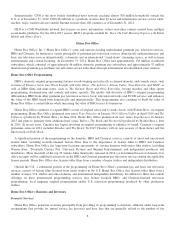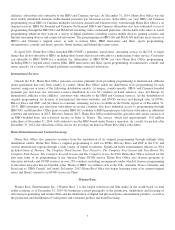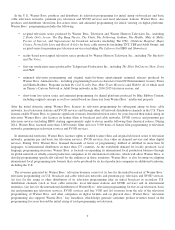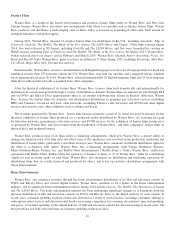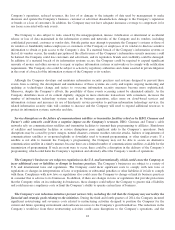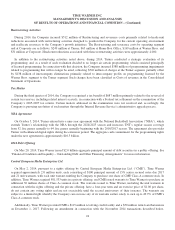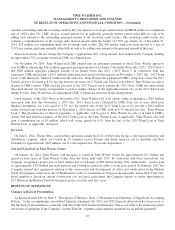Time Magazine 2014 Annual Report Download - page 32
Download and view the complete annual report
Please find page 32 of the 2014 Time Magazine annual report below. You can navigate through the pages in the report by either clicking on the pages listed below, or by using the keyword search tool below to find specific information within the annual report.• potentially adverse tax developments;
• lack of sufficient protection for intellectual property in some countries;
• territorial restrictions on content licensing;
• currency exchange restrictions, export controls and currency devaluation risks in some foreign countries, including,
but not limited to, Argentina and Venezuela;
• the existence in some countries of statutory shareholder minority rights and restrictions on foreign direct
ownership;
• the existence of quotas and other content-related limitations or restrictions (e.g., government censorship);
• restrictions on television advertising, marketing and network packaging;
• issues related to occupational safety and adherence to local labor laws and regulations;
• political or social unrest;
• higher than anticipated costs of entry;
• the presence of corruption in certain countries;
• the absence of good diplomatic relations between the U.S. and certain countries; and
• the potential for government appropriation of the Company’s assets.
One or more of these factors could harm the Company’s international operations or investments and its operating results.
In addition, some of the Company’s operations are conducted in foreign currencies, and the value of these currencies
fluctuates in relation to the U.S. dollar. The Company is exposed to foreign currency exchange rate fluctuations. Although
the Company hedges a portion of its foreign currency exposures, significant fluctuations in exchange rates in the past have
had, and in the future could have, an adverse effect on the Company’s results of operations in a given period.
Some of the Company’s businesses generate cash receipts in Venezuela. The Venezuelan government has imposed
significant limits on the exchange of local currency into U.S. dollars in recent years. Although Venezuela implemented
changes during 2014 that increase the potential to convert Venezuelan Bolivars Fuertes (“VEF”) to U.S. dollars, the
Company has been unable to exchange its VEF to U.S. dollars, and there can be no assurance as to when or if or the rate at
which the Company will be able to exchange its VEF to U.S. dollars.
Increased piracy of the Company’s content, products and other intellectual property may further decrease the revenues
received from the legitimate sale, licensing and distribution of its content and adversely affect its business and
profitability. The Company continues to be negatively affected by piracy, and an increase in the piracy of the Company’s
content, products and other intellectual property could reduce the revenues the Company earns from the legitimate sale,
licensing and distribution of its content, products and other intellectual property. The risks relating to piracy have increased
in recent years due to technological developments that have made it easier to create, distribute and store high-quality
unauthorized copies of content, such as the proliferation of cloud-based storage and streaming services, increased broadband
Internet speeds and penetration rates, and increased speed of mobile data transmission. Piracy is particularly prevalent in
countries that lack effective copyright and technical legal protections or enforcement measures, and illegitimate operators
based in those parts of the world can attract viewers from anywhere in the world. The Company devotes substantial resources
to protecting its content, products and intellectual property, but the Company’s efforts to enforce its rights and combat piracy
may not be successful.
16


